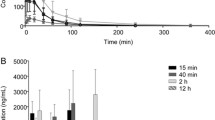Abstract
Nasal sprays containing different concentrations of the somatostatin analogue octreotide and sodium tauro-24,25-dihydrofusidate (STDHF) as an absorption promoter were evaluated in two consecutive pharmacokinetic studies in healthy volunteers to characterize their bioavailability and local tolerability. The concentrations of STDHF were selected on the basis of a phase diagram generated by a dynamic laser light-scattering technique to ensure that the mixture was above the critical micellar concentrations. Compared to a 50-µg subcutaneous injection, the nasal spray formulation without STDHF had a mean relative bioavailability of 17.9%. For nasal formulations containing 3 and 1.65% (w/v) of STDHF, the bioavailability increased to 29.0 and 25.7%, respectively. The enhancement of nasal absorption was dependent on the STDHF concentrations as shown by decreasing the amounts to 1.2 and 0.8% (w/v) for tolerability reasons; the bioavailability was reduced to 15.3 and 20.5% in these cases, respectively. The local tolerability of all STDHF-containing sprays was poor, leading to stinging sensations and lacrimation. The poor local tolerability of the octreotide nasal spray containing different concentrations of STDHF required for effective nasal absorption enhancement appears to be impractical for further clinical development. These findings clearly stress the necessity to investigate tolerability and safety issues of new drug delivery systems in early developmental phases.
Similar content being viewed by others
REFERENCES
Y. W. Chien (ed.). Transnasal Systemic Medications, Elsevier, Amsterdam, 1985.
W. A. Lee and J. P. Longenecker. Intranasal delivery of proteins and peptides. Biopharm. 1:30–37 (1988).
A. E. Pontiroli, A. Calderara, and G. Pozza. Intranasal drug delivery. Potential advantages and limitations from a clinical pharmacokinetic perspective. Clin. Pharmacokinet. 17:299–307 (1989).
P. Wuethrich and P. Buri. Revue, Intéret de la voie transnasale pour l'administration des médicaments. Deuxieme partie. Modeles d'etude de l'absorption nasal chez l'animal et parametres susceptibles d l'infuence. Pharm. Acta Helv. 65:2–13 (1990).
C. McMartin and G. Peters. Routes of administration for polar compounds of moderate weight with particular reference to analogues of somatostatin/Delivery systems for peptide drugs. In S. S. Davis, L. Illum, and E. Tomlinson (eds.), Delivery Systems for Peptide Drugs, Plenum Press, New York, 1986, pp. 255–263.
J. P. Longenecker, A. C. Moses, J. S. Flier, R. D. Silver, M. C. Carey, and E. J. Dubovi. Effects of sodium taurodihydrofusidate on nasal absorption of insulin in sheep. J. Pharm. Sci. 76:351–355 (1987).
M. J. M. Deurloo, W. A. J. J. Hermens, S. G. Romeyn, J. C. Verhoef, and F. W. H. M. Merkus. Absorption enhancement of intranasally administered insulin by sodium taurodihydrofusidate (STDHF) in rabbits and rats. Pharm. Res. 6:853–856 (1989).
P. A. Baldwin, C. K. Klingbeil, C. J. Grimm, and J. P. Longenecker. The effect of sodium tauro-24,25-dihydrofusidate on the nasal absorption of human growth hormone in three animal models. Pharm. Res. 7:547–552 (1990).
R. D. Ennis, L. Borden, and W. A. Lee. The effects of permeation enhancers on the surface morphology of the rat nasal mucosa: A scanning electron microscopy study. Pharm. Res. 7:468–475 (1990).
M. Azria. Tolerability of intranasal preparations of salmon calcitonin. In G. F. Mazzuoli (ed.), Proceedings, International Symposium Calcitonin 1988, Rome, Sandoz Ltd., Basel, Switzerland, 1989, pp. 41–47.
W. A. J. J. Hermens, P. M. Hooymans, J. C. Verhoef, and F. W. H. M. Merkus. Effects of absorption enhancers on human nasal tissue ciliary movement in vitro. Pharm. Res. 7:144–146 (1990).
G. S. Gordon, A. C. Moses, R. D. Silver, J. S. Flier, and M. C. Carey. Nasal absorption of insulin: Enhancement by hydrophobic bile salts. Proc. Natl. Acad. Sci. USA 82:7419–7423 (1985).
M. D. Katz and B. L. Erstad. Octreotide, a new somatostatin analogue. Clin. Pharmacol. 8:255–273 (1989).
J. Wynick, J. M. Polak, and S. R. Bloom. Somatostatin and its analogues in the therapy of gastrointestinal disease. Pharmacol. Ther. 41:353–370 (1989).
L. J. D. O'Donnell and M. J. Farthing. Therapeutic potential of a long acting somatostatin analogue in gastrointestinal diseases. Gut 30:1165–1172 (1989).
K. Kutz, E. Nüesch, and J. Rosenthaler. Pharmacokinetics of SMS 201-995 in healthy volunteers. Scand. J. Gastroenterol. 21 (Suppl. 119):65–72 (1986).
P. E. Battershill and S. P. Glissold. Octreotide. A review of its pharmacodynamic and pharmacokinetic properties, and therapeutic potential in conditions associated with excessive peptide secretion. Drugs 38:658–702 (1989).
All aboard for octreotide (Editorial). Lancet 336:909–911 (1990).
T. W. Papatoff, B. Narong, J. Wang, and W. A. Lee. The optimization of enhancer ratio in powder formulations of sodium taurodihydrofusidate and insulin for intranasal administration. Proc. Int. Symp. Control. Rel. Bioact. Mater. 17:462–463 (1990).
J. P. Longenecker. Nazlin®—Transdermal systemic delivery of insulin. In S. S. Davis, L. Illum, and E. Tomlinson (eds.), Delivery Systems for Peptide Drugs, Plenum Press, New York, 1986, pp. 211–220.
M. Lemaire, M. Azria, R. Dannecker, P. Marbach, A. Schweitzer, and G. Maurer. Disposition of sandostatin, a new somatostatin analogue, in rats. Drug Metab. Dispos. 17:699–703 (1989).
J. Meier, E. Nüesch, and R. Schmidt. Pharmacokinetic criteria for the evaluation of retard formulations. Eur. J. Clin. Pharmacol. 7:429–432 (1974).
M. Gibaldi and M. Perrier. Pharmacokinetics, Marcel Dekker, New York-Basle, 1982.
RS/1 for VAX and Micro VAX. Release 4 features. Bolt Beranek and Newman Inc. (BBN) Software Products Corp., Cambridge, MA, 1988.
SAS. Release 6.03, SAS Institute Inc., Cary, NC, 1988.
W. J. Conover and R. L. Iman. Rank transformations as a bridge between parametric and nonparametric statistics. Am. Stat. 35:124–129 (1981).
M. Gibaldi. Role of surface-active agents in drug absorption. Fed. Proc. 29:1343–1349 (1970).
S. J. Hersey and R. T. Jackson. Effects of bile-salts on nasal bioavailability in vitro. J. Pharm. Sci. 76:876–879 (1987).
Author information
Authors and Affiliations
Rights and permissions
About this article
Cite this article
Kissel, T., Drewe, J., Bantle, S. et al. Tolerability and Absorption Enhancement of Intranasally Administered Octreotide by Sodium Taurodihydrofusidate in Healthy Subjects. Pharm Res 9, 52–57 (1992). https://doi.org/10.1023/A:1018927710280
Issue Date:
DOI: https://doi.org/10.1023/A:1018927710280




